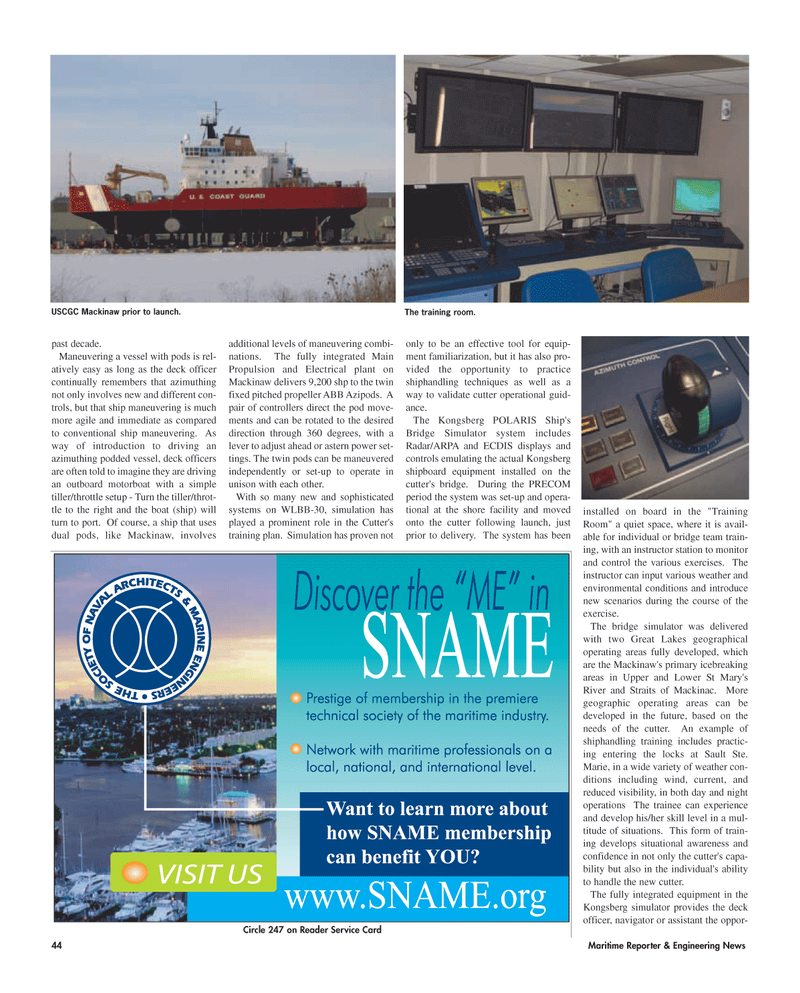
Page 44: of Maritime Reporter Magazine (July 2005)
The Satellite Communications Edition
Read this page in Pdf, Flash or Html5 edition of July 2005 Maritime Reporter Magazine
44 Maritime Reporter & Engineering News past decade.
Maneuvering a vessel with pods is rel- atively easy as long as the deck officer continually remembers that azimuthing not only involves new and different con- trols, but that ship maneuvering is much more agile and immediate as compared to conventional ship maneuvering. As way of introduction to driving an azimuthing podded vessel, deck officers are often told to imagine they are driving an outboard motorboat with a simple tiller/throttle setup - Turn the tiller/throt- tle to the right and the boat (ship) will turn to port. Of course, a ship that uses dual pods, like Mackinaw, involves additional levels of maneuvering combi- nations. The fully integrated Main
Propulsion and Electrical plant on
Mackinaw delivers 9,200 shp to the twin fixed pitched propeller ABB Azipods. A pair of controllers direct the pod move- ments and can be rotated to the desired direction through 360 degrees, with a lever to adjust ahead or astern power set- tings. The twin pods can be maneuvered independently or set-up to operate in unison with each other.
With so many new and sophisticated systems on WLBB-30, simulation has played a prominent role in the Cutter's training plan. Simulation has proven not only to be an effective tool for equip- ment familiarization, but it has also pro- vided the opportunity to practice shiphandling techniques as well as a way to validate cutter operational guid- ance.
The Kongsberg POLARIS Ship's
Bridge Simulator system includes
Radar/ARPA and ECDIS displays and controls emulating the actual Kongsberg shipboard equipment installed on the cutter's bridge. During the PRECOM period the system was set-up and opera- tional at the shore facility and moved onto the cutter following launch, just prior to delivery. The system has been installed on board in the "Training
Room" a quiet space, where it is avail- able for individual or bridge team train- ing, with an instructor station to monitor and control the various exercises. The instructor can input various weather and environmental conditions and introduce new scenarios during the course of the exercise.
The bridge simulator was delivered with two Great Lakes geographical operating areas fully developed, which are the Mackinaw's primary icebreaking areas in Upper and Lower St Mary's
River and Straits of Mackinac. More geographic operating areas can be developed in the future, based on the needs of the cutter. An example of shiphandling training includes practic- ing entering the locks at Sault Ste.
Marie, in a wide variety of weather con- ditions including wind, current, and reduced visibility, in both day and night operations The trainee can experience and develop his/her skill level in a mul- titude of situations. This form of train- ing develops situational awareness and confidence in not only the cutter's capa- bility but also in the individual's ability to handle the new cutter.
The fully integrated equipment in the
Kongsberg simulator provides the deck officer, navigator or assistant the oppor-
Circle 247 on Reader Service Card
USCGC Mackinaw prior to launch. The training room.
MR JULY2006 #6 (41-48).qxd 7/5/2006 12:01 PM Page 44

 43
43

 45
45
